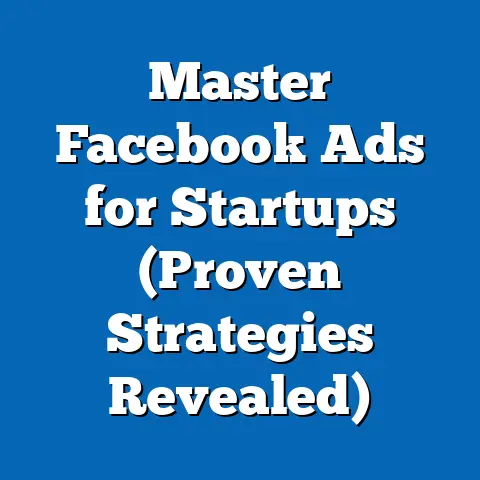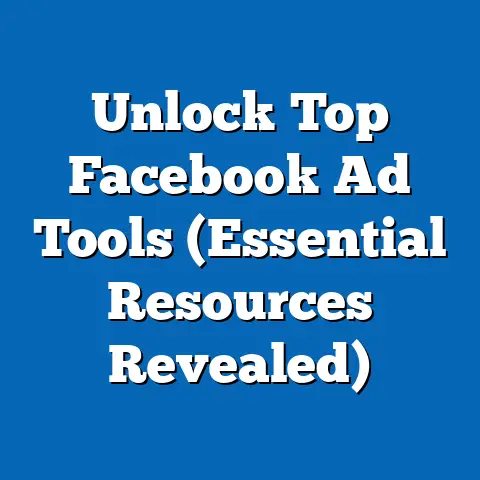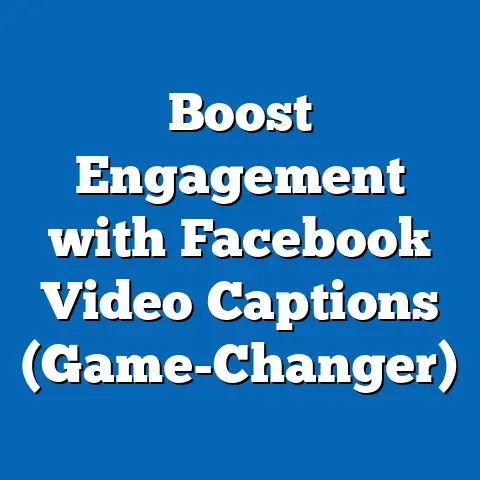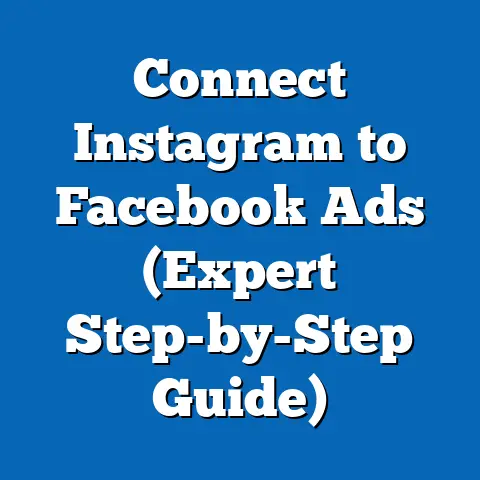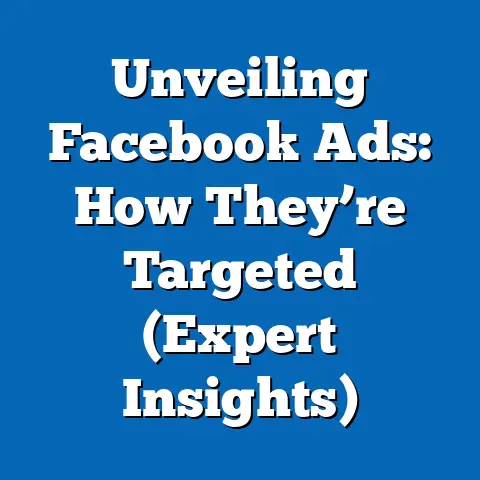Mastering Facebook Ads Parameters (Pro Strategies Revealed)
I remember the first time I truly understood the power of Facebook advertising. I was working with a small, family-owned bakery struggling to compete against larger chains. They had amazing products, but their marketing reach was limited. They’d tried everything – local newspaper ads, flyers, even sponsoring a little league team – but nothing seemed to stick. Initially, they were hesitant about Facebook ads, thinking it was too complicated and expensive. “It’s just for the big guys,” they’d say.
But I convinced them to give it a try, starting with a small budget and a very specific target audience: people within a five-mile radius who had expressed interest in baking or local businesses on Facebook. The results were almost immediate. Within a week, they saw a noticeable increase in foot traffic and online orders. What really blew their minds (and mine, to be honest) was the level of control we had. We could tweak our targeting, change our ad copy, and adjust our budget in real-time, based on the data we were seeing. That’s when I realized the transformative potential of mastering Facebook ad parameters.
Understanding and strategically using these parameters isn’t just about creating ads; it’s about crafting a highly targeted, optimized, and ultimately successful marketing campaign. It’s about reaching the right people, with the right message, at the right time, and within the right budget. In this guide, I’ll break down the essential Facebook ad parameters and share pro strategies I’ve learned over the years to help you achieve the best possible return on your investment.
Understanding Facebook Ads Parameters
Facebook Ads parameters are the adjustable settings and options you use to define and control your advertising campaigns. They are the building blocks of your ad strategy, dictating who sees your ads, where they appear, how much you spend, and what actions you want people to take. Without a firm grasp of these parameters, you’re essentially throwing money at the wall and hoping something sticks.
Think of it like baking a cake. You can’t just throw ingredients together and expect a delicious result. You need to understand the role of each ingredient (flour, sugar, eggs) and how they interact with each other. Similarly, with Facebook ads, you need to understand the role of each parameter and how they influence your campaign’s performance.
Here are some of the key types of parameters you’ll encounter:
- Audience Targeting: This includes demographic data (age, gender, location), interests, behaviors, connections, and custom/lookalike audiences.
- Placement Options: You can choose where your ads appear, such as Facebook news feed, Instagram feed, Audience Network, Messenger, and more.
- Budget Settings: This involves setting a daily or lifetime budget, as well as deciding on a bid strategy.
- Bid Strategies: You can choose between manual bidding (where you set the amount you’re willing to pay per click or impression) and automatic bidding (where Facebook optimizes your bids for the best results).
- Ad Formats: Facebook offers a variety of ad formats, including images, videos, carousels, collections, and lead ads.
These parameters don’t exist in isolation. They interact and influence each other in complex ways. For example, a poorly defined audience targeting strategy can lead to wasted ad spend, even if you have a compelling ad creative. Similarly, a low budget can limit your reach, even if you have a perfectly targeted audience.
Example: Let’s say you’re selling handmade jewelry. If you target a broad audience like “people interested in fashion,” you might reach a lot of people who aren’t interested in handmade items or are outside your shipping range. However, if you refine your targeting to “people interested in handmade jewelry, Etsy, and vintage fashion” within a specific geographic area, you’re more likely to reach potential customers who are genuinely interested in your products.
Takeaway: Understanding how these parameters work together is essential for creating effective and efficient Facebook ad campaigns.
Audience Targeting Strategies
Audience targeting is arguably the most powerful feature of Facebook ads. It allows you to reach specific groups of people based on their demographics, interests, behaviors, and connections. This level of precision is unparalleled in traditional advertising, and it’s what makes Facebook ads so effective. I’ve seen campaigns go from complete flops to resounding successes simply by refining the audience targeting.
Facebook offers three main types of audiences:
- Core Audiences: These are audiences you create based on demographic data, interests, and behaviors. You can target people based on their age, gender, location, education, job title, interests (e.g., “yoga,” “travel,” “cooking”), and behaviors (e.g., “frequent travelers,” “online shoppers,” “early adopters”).
- Custom Audiences: These are audiences you create based on your own data, such as email lists, website visitors, or app users. You can upload your customer list to Facebook and target those specific people with your ads. You can also create audiences based on people who have visited specific pages on your website or taken specific actions in your app.
- Lookalike Audiences: These are audiences that Facebook creates based on your existing audiences. You can tell Facebook to find people who are similar to your best customers or website visitors. This is a great way to expand your reach and find new potential customers who are likely to be interested in your products or services.
Pro Strategies for Refining Audience Targeting:
- Layer Your Targeting: Don’t just target “people interested in fashion.” Layer your targeting by adding demographic data, behaviors, and other interests. For example, target “women aged 25-45 who are interested in fashion and online shopping and who have recently purchased clothing online.”
- Use Website Retargeting: Retargeting is one of the most effective advertising strategies. Create audiences based on people who have visited specific pages on your website or added items to their cart but didn’t complete the purchase. Show them ads featuring the products they were interested in, and offer them a discount or free shipping to encourage them to complete the purchase. I’ve seen retargeting campaigns consistently outperform other types of campaigns in terms of conversion rates and ROI.
- Experiment with Lookalike Audiences: Lookalike audiences can be a goldmine for finding new potential customers. Start by creating a lookalike audience based on your best customers or website visitors. Then, experiment with different percentage ranges (e.g., 1%, 5%, 10%) to see which one performs best.
- Exclude Existing Customers: If you’re running ads to promote a new product or service, exclude your existing customers from your targeting. You don’t want to waste ad spend showing ads to people who have already purchased your product. Instead, target them with ads for complementary products or services.
- Test Different Audience Segments: Don’t put all your eggs in one basket. Create multiple audience segments based on different demographics, interests, and behaviors. Then, test different ad creatives and messaging for each segment to see what resonates best.
Case Study: I worked with an e-commerce company selling organic skincare products. Initially, they were targeting a broad audience of “people interested in skincare.” Their results were mediocre. After analyzing their customer data, we discovered that their best customers were women aged 30-50 who were interested in organic products, healthy living, and environmental sustainability. We created a new audience segment based on these criteria and saw a dramatic improvement in their ad performance. Their click-through rates increased by 50%, and their conversion rates doubled.
Takeaway: Audience targeting is a powerful tool, but it requires careful planning and experimentation. By refining your targeting and testing different audience segments, you can significantly improve your ad performance and ROI.
Crafting Compelling Ad Creatives
While audience targeting gets your ads in front of the right people, compelling ad creatives are what make them stop scrolling and take action. Your ad creative is your first (and often only) chance to make a good impression. It needs to be visually appealing, attention-grabbing, and relevant to your target audience.
There are three key elements to consider when crafting ad creatives:
- Visuals: Use high-quality images or videos that are relevant to your product or service. The visual should be eye-catching and tell a story. Consider using lifestyle images that show people using your product in a natural setting.
- Ad Copy: Your ad copy should be concise, clear, and persuasive. Highlight the benefits of your product or service and explain why people should buy it. Use strong action verbs and create a sense of urgency.
- Call-to-Action (CTA): Your CTA should tell people exactly what you want them to do. Use clear and specific language, such as “Shop Now,” “Learn More,” “Sign Up,” or “Get Started.”
Insights into A/B Testing for Creatives:
A/B testing is the process of testing different versions of your ad creative to see which one performs best. You can test different visuals, ad copy, CTAs, and even ad formats.
- Test One Element at a Time: When A/B testing, only change one element at a time. This will allow you to isolate the impact of that specific element on your ad performance. For example, test two different visuals with the same ad copy and CTA. Then, test two different ad copy variations with the same visual and CTA.
- Use a Large Enough Sample Size: Make sure you have a large enough sample size to get statistically significant results. The larger your sample size, the more confident you can be that your results are accurate.
- Track Your Results: Use Facebook Ads Manager to track your results and see which variations are performing best. Pay attention to metrics like click-through rates, conversion rates, and cost per acquisition.
Expert Tips for Designing Ads that Resonate with Specific Audiences:
- Know Your Audience: Understand your target audience’s needs, wants, and pain points. Use this knowledge to craft ad creatives that speak directly to them.
- Use Emotion: Connect with your audience on an emotional level. Use visuals and ad copy that evoke feelings of joy, excitement, or nostalgia.
- Show Social Proof: Use testimonials, reviews, and case studies to build trust and credibility.
- Keep it Simple: Don’t overwhelm your audience with too much information. Keep your ad creatives simple and easy to understand.
Takeaway: Compelling ad creatives are essential for capturing attention and driving conversions. By A/B testing different variations and following these expert tips, you can create ads that resonate with your target audience and achieve your advertising goals.
Budgeting and Bidding Strategies
Setting the right budget and choosing the right bidding strategy are crucial for maximizing your return on investment. You can have the best audience targeting and ad creatives in the world, but if you don’t manage your budget effectively, you’ll end up wasting money.
Facebook offers two main budget settings:
- Daily Budget: This is the average amount you’re willing to spend per day on your ad campaign. Facebook will try to spend this amount each day, but it may spend slightly more or less depending on performance.
- Lifetime Budget: This is the total amount you’re willing to spend on your ad campaign over its entire duration. Facebook will try to spread your budget evenly over the campaign’s duration, but it may spend more on some days and less on others.
When to Use Each:
- Daily Budget: Use a daily budget if you want to run your ads continuously and maintain a consistent level of spending.
- Lifetime Budget: Use a lifetime budget if you want to run your ads for a specific period of time and have a fixed budget to work with.
Facebook also offers two main bidding strategies:
- Manual Bidding: With manual bidding, you set the amount you’re willing to pay per click or impression. This gives you more control over your spending, but it also requires more monitoring and adjustment.
- Automatic Bidding: With automatic bidding, Facebook optimizes your bids for the best results based on your campaign objectives. This is a good option if you’re new to Facebook advertising or if you want to save time and effort.
Pro Tips on How to Effectively Allocate Budgets Across Campaigns:
- Start Small: Start with a small budget and gradually increase it as you see positive results. This will allow you to test different strategies and optimize your campaigns without risking too much money.
- Allocate Budget Based on Performance: Allocate more budget to the campaigns that are performing best. If a campaign is generating a high return on investment, increase its budget to maximize your results.
- Monitor Your Performance Regularly: Keep a close eye on your ad performance and make adjustments as needed. If a campaign is not performing well, pause it or reduce its budget.
- Use Budget Rules: Facebook allows you to create budget rules that automatically adjust your budget based on performance. For example, you can create a rule that automatically increases your budget if your cost per acquisition is below a certain threshold.
Example of Successful Budgeting Strategies:
I worked with a local restaurant that wanted to promote their new lunch menu. They had a limited budget of $500 per month. We decided to use a daily budget of $16.67 (500 / 30). We targeted people within a 5-mile radius of the restaurant who were interested in food, dining, and local businesses. We created ad creatives featuring mouth-watering photos of their lunch menu items and a CTA to “Order Now.”
We monitored their ad performance closely and made adjustments as needed. We discovered that their ads were performing best during lunchtime hours (11 AM – 2 PM). So, we adjusted their ad schedule to only run during those hours. We also discovered that their ads were performing better on mobile devices than on desktop computers. So, we optimized their ads for mobile devices.
As a result of these strategies, the restaurant saw a significant increase in lunch orders. They were able to generate a positive return on their investment and attract new customers.
Takeaway: Budgeting and bidding strategies are essential for maximizing your return on investment. By setting the right budget, choosing the right bidding strategy, and monitoring your performance regularly, you can achieve your advertising goals without breaking the bank.
Analyzing and Optimizing Performance
Tracking ad performance is crucial for understanding what’s working and what’s not. Without data, you’re just guessing. Facebook Ads Manager provides a wealth of information about your ad performance, including impressions, reach, clicks, click-through rates, conversion rates, and cost per acquisition.
Key Performance Indicators (KPIs) to Monitor:
- Impressions: The number of times your ad was shown to people.
- Reach: The number of unique people who saw your ad.
- Clicks: The number of times people clicked on your ad.
- Click-Through Rate (CTR): The percentage of people who saw your ad and clicked on it.
- Conversion Rate: The percentage of people who clicked on your ad and completed a desired action, such as making a purchase or signing up for a newsletter.
- Cost Per Acquisition (CPA): The cost of acquiring one customer through your ad campaign.
- Return on Ad Spend (ROAS): The revenue generated for every dollar spent on advertising.
Strategies for Ongoing Optimization:
- A/B Testing: Continuously test different variations of your ad creatives, targeting, and bidding strategies to see what performs best.
- Refine Your Targeting: Analyze your audience data to see which demographics, interests, and behaviors are driving the best results. Refine your targeting based on these insights.
- Adjust Your Bids: Monitor your cost per acquisition and adjust your bids accordingly. If your CPA is too high, lower your bids. If your CPA is too low, increase your bids.
- Improve Your Ad Creatives: Analyze your ad creatives to see which ones are generating the best results. Experiment with different visuals, ad copy, and CTAs.
- Optimize Your Landing Page: Make sure your landing page is relevant to your ad and easy to navigate. Optimize your landing page for conversions.
Success Stories of Brands that Have Effectively Analyzed and Optimized Their Campaigns:
I worked with a SaaS company that was struggling to generate leads through Facebook ads. They were getting a lot of impressions and clicks, but their conversion rates were low. After analyzing their data, we discovered that their landing page was not optimized for conversions. The landing page was too long, it didn’t have a clear call-to-action, and it wasn’t mobile-friendly.
We redesigned their landing page, making it shorter, more concise, and mobile-friendly. We also added a clear call-to-action. As a result, their conversion rates increased by 200%, and their lead generation costs decreased by 50%.
Takeaway: Analyzing and optimizing your ad performance is an ongoing process. By tracking your KPIs, A/B testing different variations, and making data-driven adjustments, you can continuously improve your results and maximize your return on investment.
Conclusion
Mastering Facebook ads parameters is not a one-time task; it’s an ongoing process of learning, experimenting, and optimizing. By understanding the different parameters, refining your audience targeting, crafting compelling ad creatives, managing your budget effectively, and analyzing your performance regularly, you can unlock the full potential of Facebook advertising and achieve your business goals.
Facebook ads can be a powerful tool for businesses of all sizes. Whether you’re a small, family-owned bakery or a large e-commerce company, Facebook ads can help you reach your target audience, generate leads, and drive sales. The key is to approach it strategically, with a clear understanding of the parameters and a willingness to experiment and optimize.
Don’t be afraid to try new things, test different strategies, and learn from your mistakes. The more you practice, the better you’ll become at mastering Facebook ads parameters and achieving success.
Call to Action:
What are your biggest challenges with Facebook ads? Share your experiences or ask questions in the comments below! I’d love to hear from you and help you on your Facebook advertising journey.


